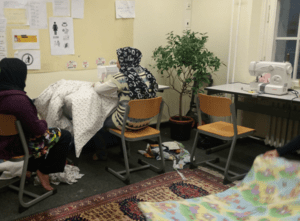The Women’s Room: A Report from Berlin’s Refugee Centers
When I log on to the Volunteer Planner for helping at Berlin’s refugee centers I see the current tally of volunteers and hours worked: 18,000+ registered volunteers, 50,000+ hours worked. This makes me think of former President George H.W. Bush’s phrase “a thousand points of light.” Thousands in Germany are lighting the way towards a new life for thousands seeking asylum.
Berliners are opening their homes, signing up to serve food and distribute clothing, and bringing emergency relief supplies to those waiting outdoors to register for asylum. Volunteers are engaged in countless daily tasks to help tens of thousands of refugees take their first steps towards integration.
I’m one of the 18,000 people registered to volunteer through the State Office for Health and Social Affairs in Berlin. I had not put in many hours before the Paris terror attacks, but increasing my efforts seemed like the best response to those who would reverse course in welcoming refugees to Germany. Volunteering is also a way to cope with a burning sense of grief for 130 lost lives.
At Rathaus Wilmersdorf, one of Berlin’s eighteen relief centers, I recently volunteered in the Frauenzimmer (women’s room), a place for women to relax, chat, sew, apply make-up, and listen to music. I was hoping to be kept busy doing things that would make a difference to someone, but my fellow volunteer and I did not receive any specific instructions and there wasn’t a lot for us to do.
As women filtered in and out of the room with their children, we exchanged awkward smiles and stilted greetings. I tried to discern whether they were speaking Arabic, Farsi, or Urdu, scanning the wall posters for key phrases that might help me to communicate. I felt like an outsider, blocked from offering emotional support by language barriers and my inability to connect my life’s experience with theirs. I had no way to tell them that my parents were also refugees who fled annihilation at the hands of Hitler’s executioners in a different Germany.
One of the few specific tasks we had was to unlock the closets that house sewing and craft supplies, along with make-up, perfume, lotion and other toiletries. My hopes for a way to connect were raised as I unlocked the doors and anticipated sharing the universal female ritual of a beauty session. But instead of bonding over cosmetics, a few of the women grabbed plastic bags and started filling them with little bottles and containers while their kids darted in among us trying to take anything they could get their hands on.
How do you tell a woman who has lost almost everything not to take too many beauty supplies for herself? Our efforts to stop the “perfume heist” were half-hearted and it took a while until we were able to secure the closets from further raids. By then the women were long gone from the Frauenzimmer.
The 800 people sheltered at Rathaus Wilmersdorf are in a clean, well-organized, and safe environment where they have access to medical care, regular meals, translation services, language classes, and a seemingly endless supply of donated clothing. Their physical needs are being met with characteristic German efficiency, but that’s an easier task than meeting their mental and emotional needs.
While far-right groups spew a steady stream of warnings that Islamic immigrants may be terrorists, a more pressing concern is that refugees will not have access to adequate psychological and social services. Survivors of trauma, whether through war, genocide, or natural disaster, have common needs to reclaim their individuality and dignity. As asylum applications are approved and thousands of migrants begin to rebuild their lives in Europe and North America, integration demands that we pay as much attention to these issues as we do to securing our borders from terrorists.
Although I teach a college intercultural communications course, cultural differences and communication barriers challenged me during my volunteer shift in the women’s room. Towards the end of the shift a number of volunteers brought out sewing machines and big swaths of colorful fabrics. A small group of Syrian and Afghani women were soon busy sewing baby blankets while the German volunteers stood by to provide prompt and cheerful assistance. Their efforts demonstrated how small gestures can bridge cultural gaps and help the displaced launch new beginnings.
Right before it was time for me to leave a verbal fight broke out between two of the women. More seasoned volunteers told me that there are tensions between the different ethnic groups at the shelter. Though I wasn’t able to help resolve the conflict, I will continue to volunteer along with thousands of other Berliners. The biggest danger we face is from not doing enough to respond to this humanitarian crisis.







